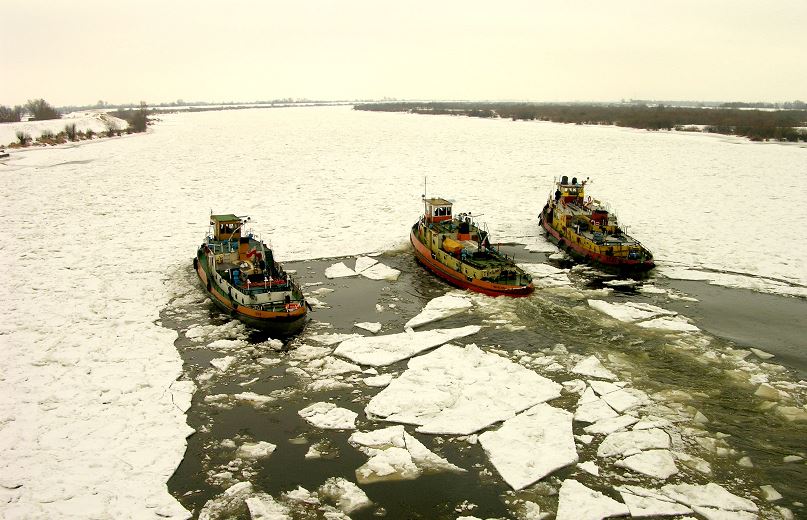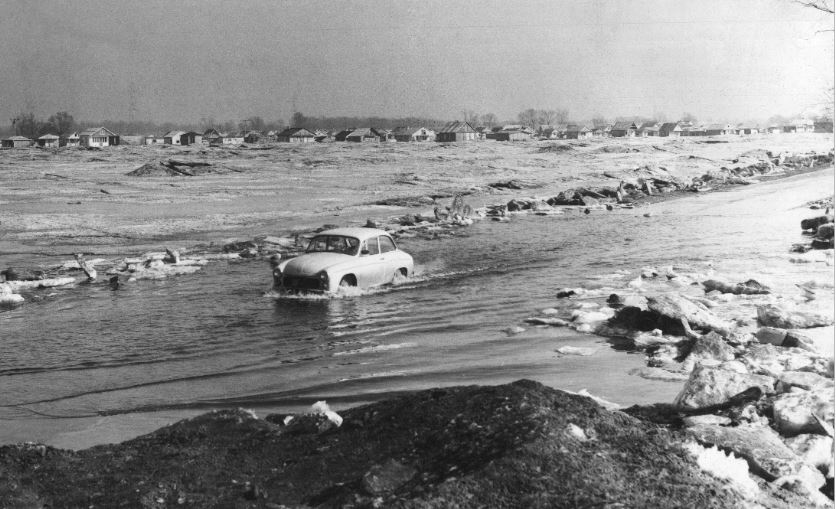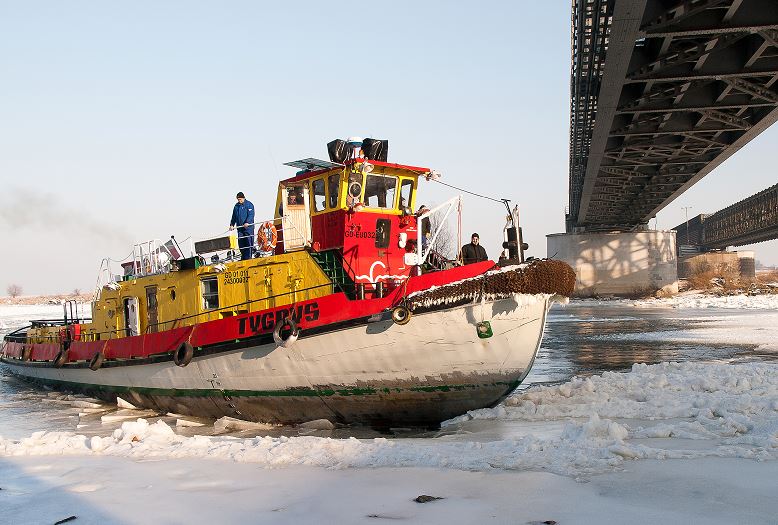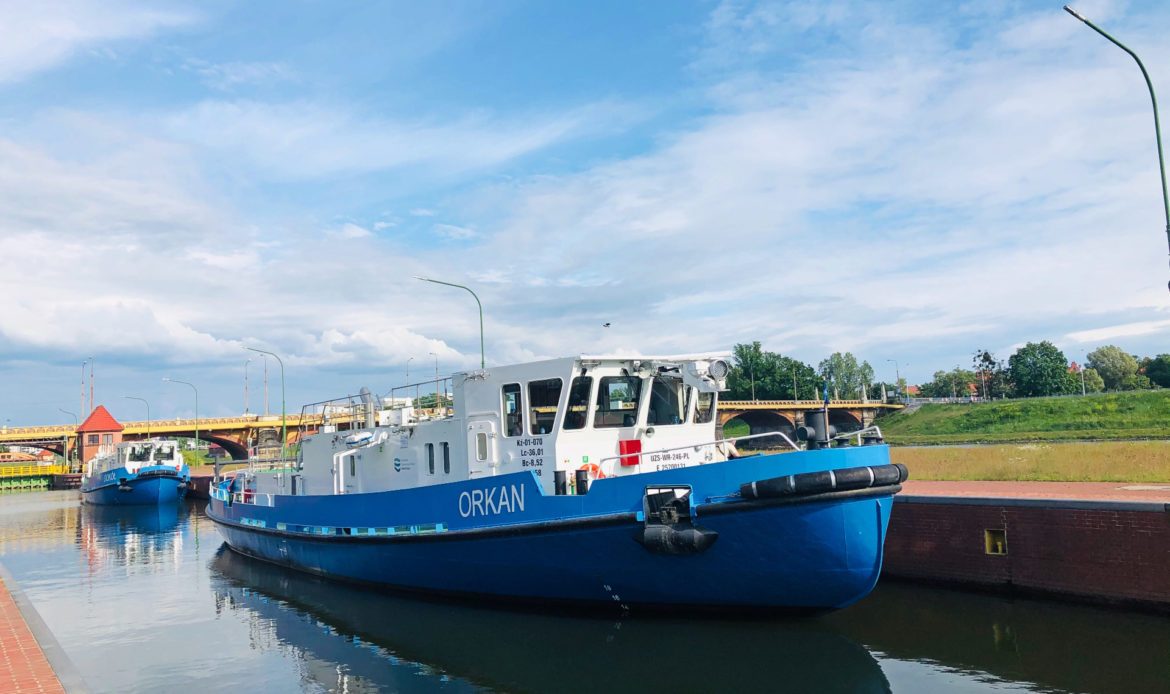Text: Jowita Hakobert
Let us imagine that the icebergs known from Titanic appear on the river out of a sudden, the water level rises and burst the banks… This is what ice jam floods can look like. To prevent them, icebreakers must come into play. Our experts explain how ice jams are created, how they can be prevented and what the icebreaking action course is.
If water is in a permanent reservoir, it simply freezes when frost comes, creating a homogeneous cover resembling a skating rink. But the river water is “lively”, flowing faster or slower, so the freezing process looks different. “First, ice crystals are formed, the so-called frazil ice, which mostly float on the water surface. However, if they encounter some obstacle, e.g. a bridge pier, they start to accumulate. The ice getting under the existing ice cover builds up vertically and can evolve into icebergs of an irregular shape. This can be compared to a traffic jam. When more vehicles approach the crossroads than leave it, a jam is formed. However, contrary to drivers, ice “does not think” so it goes forward even if there is no space for it to move on. An ice jam is formed. When excessive amount of ice is gathered somewhere, it will be more difficult for the river water to run off until it bursts the banks eventually. This is why the ice jam can cause flood”, dr hab. inż Tomasz Kolerski, Professor of the Technical University in Gdańsk who has studied the jam processes in rivers and water reservoirs for 20 years, explains.
Difficult to foresee
It is not easy to foresee an ice jam flood. “We need to base mostly on observations. The posts of the Institute of Meteorology and Water Management provide information on ice, including whether this is ice accumulating at the banks or floating, what its concentration is etc. A good clue is also to observe what happens to it. The rising ice often leaves the river bed and then can rub against nearby trees, leaving the so-called ice scars created when ice removes tree bark. Analysing similar situations over years, we know which places are prone to the ice jam formation. An important point of reference is the water table location as it can tell us how much ice has accumulated so far. If we know e.g. that the water level rose at some measuring post with no increased water flow rate, this indicates that there is an ice jam between the said post and the subsequent one where the water level did not rise”, says dr Kolerski.
Ice jam floods are a dangerous phenomenon, highly dynamic one, but they may go unnoticed when there is any local damming up of water which inundates a part of some meadow. However, in Poland there are some places particularly prone to the ice jam formation. “They include certainly the Lower Vistula region because of two sites, i.e. the reservoir in Włocławek and the Vistula mouth. Another relatively sensitive point is the damming structure for the combined heat and power plant in Kozienice. The Lower Oder is encumbered with a similarly high risk, mostly the border section, at the level of Widuchowa, where the river bed splits into two arms, i.e. the West Oder and the East Oder flowing into Dąbie Lake. Water flows more slowly then so the frazil ice accumulates vertically fast there”, says dr Kolerski
Attention, there is a jam!
Ice jam evolution can be divided into three stages, i.e. formation, cover and breakdown which is often connected with the fact of ice starting to move. It seems as if a huge iceberg was flowing down the river.
“The entire ice jam can be up to 2 m thick so its uncontrolled movement is a highly dangerous phenomenon. If such a huge body composed of a chaotically structured ice floe starts to move and strikes some obstacle, e.g. a bridge, it can damage it. And if it stops somewhere, it can block water flow and, dam it consequently resulting in bursting the banks and flood. So when some ice jam which can move any time due to the upcoming thawing weather was confirmed on a river, icebreakers are brought into play”, says dr Kolerski.
“First, they must break the ice cover and prepare some space for the ice and water logged upstream it to run off. Doing that, they create the so-called ice trough in the jam and downstream it. It is a “bypass” for the ice jam. It function can be compared also to the safety valve for dammed water which may flow downstream along the trough. Icebreakers go upstream and broaden that trough in a systematic fashion”, the expert adds.

Activities at the Border Oder
The icebreaking actions in our climate are the most effective method to prevent ice jam floods on large rivers. Under the understanding of 1997, at the border Oder they also cooperate with six German vessels. “Lower sections of the Oder, the Vistula and Włocławek region are the major “flashpoints” though ice breaking actions are carried out at the upper canalised section of the Oder and at the lower sections of the Warta and the Noteć as well. For them to occur, specific conditions must be met. On small rivers with numerous meanders and shoals icebreakers cannot be used due e.g. to insufficient depth of water”, says Krzysztof Woś, Deputy President of Wody Polskie for Flood and Drought Protection who was the technical head of the Polish and German icebreaking action at the border and lower Oder section.
Different specialisations
To complete the action effectively, the appropriate number of icebreakers with qualified crew is required which must also have different technical parameters, i.e. draught (due to varying depths) and widths and heights (due to the parameters of bridge piers restricting free navigation).
Icebreakers taking part in the action are divided into two groups, e.g. front and line ones. The “front” operations are carried out by at least two vessels accompanied by at least two line icebreakers along the route. Once the “front” moves upstream which extends the ice run off path, other line icebreakers join the action to prevent any halting of the run-off floe.

Like playing chess
For icebreakers to start their operation, thawing weather is required. “Otherwise, our work would go down the drain as the broken ice would freeze again, creating a prospective risk of another jam”, Krzysztof Woś explains. Regardless of the local hazard site at the Oder, lower sections of the Warta and Noteć, every icebreaking action starts from Dąbie Lake in Szczecin. “It is the main collector of ice floe running off those rivers. Icebreakers always move upstream to ensure the ice broken by them has some place to run off. This is why any icebreaking action on the Warta river is always started only once the Oder is made passable. For the Vistula, icebreakers first enter Gdańsk Bay from the Vistula mouth, passing Świbno, Kiezmark and reaching Tczew or above”, Krzysztof Woś explains. Icebreaking can take from less than a dozen to several dozen days. The action requires an appropriate strategy. Icebreakers always operate in groups and cooperation between them is of high importance. First comes the “front”, meaning two or three front icebreakers which break the ice cover and, if it is too thick, they gather speed and hit the ice, breaking it with their weight. During the day, the “front” group breaks the amount of ice which the line icebreakers are able to remove without the risk of the broken ice floe halt. During the icebreaking action, the most effective communication method is the radiotelephone one ensuring simultaneous reception of the message by all stations (both onshore and vessel ones) using the same channel. This means e.g. that the information concerning the current ice-related situation passed to the action leaders by front icebreakers is also received by line icebreakers which know the progress of the front group and the amount of ice they need to remove without allowing it to halt. It is similar when the action leaders talk to the line icebreakers or onshore observers, or when the icebreakers talk with one another. “Given the icebreaking action progress upstream, the navigation conditions, i.e. depths, decrease. Then, huge and strong icebreakers in the “front” group are replaced by smaller ones which were line vessels so far. The icebreaking action can be compared to playing chess: you need to be able to sense the moment when it is worth taking a step backward to be able to move forward later”, Krzysztof Woś, Deputy President of Wody Polskie for Flood and Drought Protection, explains.
Patience pays off
Work on icebreakers requires experience, intuition, but also patience.
“Captains working in our fleet know what force should be applied to hit the ice, when to withdraw, what pieces the ice cover is to be broken into to enable it to run off freely. But they are also aware that the action may take a long time as e.g. the river is clogged with ice floe so much that the ice has no place to run off or some northern wind blew and the so-called backwater occurred giving us the backward current when the broken floe returns. Icebreakers cannot move forward then but they need to go around and wait for the weather to change”, says Krzysztof Woś. Different stressful situations occur. “In 2006, we had a jam on the Oder river. My phone was heated red-hot, I was called by the people from Nowa Sól and Cigacice who asked when the “front” icebreakers would reach them at last. If water raised 5 cm higher, it would start overflowing the embankment! And I would comfort them, saying we were coming to them, asking them to wait another while… The action took some 20 days more, ice kept coming all the time so the jam was getting bigger and bigger and we moved very slowly. But we managed to get to Cigacice at the last minute. I remember the residents left their houses and started to cheer. They welcomed us like war heroes!”, Krzysztof Woś recollects. “Those are the times of utmost satisfaction with our work. When there is a jam, we break it and this prevents danger”, he adds.
For the good of navigation
The work of icebreakers does not only prevent floods, but it also makes ship routes passable. “In the past, navigation was impossible in winter, i.e. from ca. 15 November to 15 March. There are many commercial companies today so everyone wants the ship routes to stay passable as long as possible. An effective and safe icebreaking action reduces the navigation closure at waterways due to their ice cover. However, the ice run off will not enable us to open the route the following day. First, we need to perform the so-called sweeping (looking for underwater obstacles), next we use sonic depth finders which are units checking for the best depths, then the route is marked and only then it can be opened again”, Krzysztof Woś, Deputy President of Wody Polskie, explains.
Włocławek ’82
The most serious so far, catastrophic ice jam flood took place at the Vistula at the section from Wyszogród to Włocławek between December 1981 and January 1982. The flood protection action and intense struggle with its effects was carried out in the river bed, at the Water Reservoir in Włocławek and adjacent areas as long as 10 March 1982. “That was a disaster but the conditions in which the flood occurred were exceptional as well”, Krzysztof Polak, an expert in the Investment Preparation and Implementation Department in Wody Polskie, having professional ties with the Włocławek Reservoir, recollects.

It was like that…
First, there were really low temperatures, everything was covered by snow and frozen, then thawing weather came suddenly which thawed everything, and soon later a wave of freezing air from the North to Poland followed.
“In Krakow, the temperature was five degrees above zero, but in Gdańsk it was twenty below zero, so the Vistula froze upstream, halting and covering with ice. The ice floe and frazil ice from the upper sections of the Vistula river created jams of unknown sizes in the central and upper part of the Włocławek reservoir. Icebreaking actions were not effective then, but the icebreakers those days had lower power. The weir gate valves were frozen so they could not be moved. One steam-driven icebreaker served as a steam generator and heated them so that they could be raised. Let us remember that it was the time of Martial Law and there was no communication. Subsequent generals would come to Włocławek, giving contradictory decisions. One of them ordered to drain the reservoir so the ice stuck to the bottom and then another one came and ordered to dam up water, but it was too late. The third one wanted to blow the weir up”, dr Krzysztof Polak recollects.
Modernisation and safeguards
Luckily, conclusions were drawn and various activities were initiated to protect Włocławek from a similar flood. “We based on the experiences of experts from the United States, Canada and Scandinavia. Following their example, we started to place frazil ice baffles. At present, we install such a baffle in Popłacin for winter. Its task is to hold the frazil ice before the reservoir and to promote ice cover formation which improves the icebreaking efficiency”, says dr Polak. The fleet of icebreakers and their power were also increased significantly. The icebreakers those days had the power of 400 kW, the present ones have 800 kW each, and the front one as much as 1,000 kW. What is more, a trough was made in the reservoir, all tussocks and shallows were removed. The bottom trough is 400–500 m wide and ensures unrestricted ice transit. To create it, more than 14 million cc of sediments and sand were removed from the river bed. They were used to make an extensive beach scarp, but also to raise side dams. “In the peak period of the modernisation, 20 dredgers were operating at the reservoir!”, dr Polak recollects. In Radziwie, a district of Płock which suffered most during the flood in 1982, a flood gate was constructed. Also the weir closures were replaced by gate valves with a flap which facilitate ice passage. To prevent the gate valves from freezing, the so-called bubbling is used in winter. “Hoses are led along the bottom from the head water and from the sluice and air is supplied through them. The bubbles generated by it move upward, taking water with them, so it cannot freeze and create a layer of ice on the gate valve”, dr Krzysztof Polak explains.
“We carried out analyses indicating that there would not be a similar calamity given present flood protections. Now, to offer further protection from flood to Płock and Włocławek, it is the most important to construct another Stage of Fall on the Vistula under the Vistula Cascading project. Wody Polskie carries out intense works in this respect”, the expert assures.
Like a ready army
The example of Włocławek proves what can be done to prevent ice jam floods but is it possible to do something more? “It is important to create groins, i.e. control structures made from natural materials (stone or fascine). Thanks to them, we reduced the risk of possible ice jam formation on the Oder. Now the debris taken from the bottom by water on which ice could accumulate is not deposited directly on the river but on the fields between the groins”, says Krzysztof Woś.
Due to climate changes, icebreakers do not need to operate every year. “According to my analysis, icebreaking actions were organised seven out of 10 years. Today this is different. In every 10-year period, there are two or three winters when the icebreakers are put into use”, says Krzysztof Woś, Deputy President of PGW WP.
“The average temperature rises. In the past, rivers and reservoirs would freeze in mid-December, but now it occurs in January or does not happen at all. What is more, winters were more foreseeable. When frost came, it did not give up. Now it can change overnight so we need to be more alert”, dr Tomasz Kolerski stresses.
This is exactly why the fleet of icebreakers belonging to Wody Polskie is on standby from December to March although the most recent icebreaking action took place in 2018. “As generals put it: it is worth keeping the army for 50 years so that it wins a single battle. It is similar for icebreakers. They do not have to set off every year but they are ready in emergency and will be brought into play should the need arise”, Krzysztof Woś, Deputy President of Wody Polskie for Flood and Drought Protection, summarizes.
Icebreaker fleet of Wody Polskie.
Cutting-edge icebreakers of Wody Polskie are stationed in Szczecin, Gdańsk, Włocławek and Wrocław and are ready for action. Their operation is necessary to avoid dangerous ice jam floods which may occur in winter. A highly dangerous winter flood in Poland took place between December 1981 and January 1982. The most recent icebreaking action took place in 2018 when ice jams on the Oder river were formed. Below, please see the information on the icebreaker fleet of Wody Polskie and facts concerning the reasons of ice jam floods formation and methods to prevent a hazard.
The icebreaker fleet of Wody Polskie comprises 25 vessels now. Puma, Sokół, Orkan and other vessels with a double hull, designed to operate in extreme conditions, are ready to start the icebreaking action whenever any emergency occurs. New icebreakers are being constructed in Polish shipyards. Their target number in the fleet of PGW WP is to reach 30.
Icebreakers are required to remove ice jams likely to form in different sites prone to it. The Lower Vistula region faces particular hazard due to two sites, i.e. the reservoir in Włocławek and the Vistula mouth. Also the Lower Oder is sensitive, including but not limited to the border Oder.
Starting from 1 December 2020, 7 Polish icebreakers are ready to participate in the icebreaking action on the border Oder in the area administered by Wody Polskie RZGW in Szczecin. One additional icebreaker, ready to join should the need arise, is also on call. What is more, 6 German icebreakers are ready to operate.
“Wody Polskie RZGW in Szczecin and our German partners are ready to act. For several days, according to weather forecast, regular temperature decrease below zero are possible which, for obvious reasons, contributes to our alertness and preparedness for icebreaking and interventions”, says Marek Duklanowski, Director of Wody Polskie RZGW in Szczecin. “The icebreaking action on the Oder covers several operational regions of the icebreaker fleet where independent icebreaker teams can operate during the action at the same time. The major areas of icebreaker operational activities include Dąbie Lake and Regalica, Widuchowa node, the border Oder and Lower Warta. The icebreaking action on the border Oder is led by Wody Polskie”.


